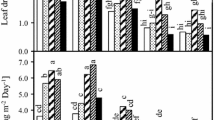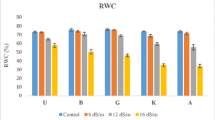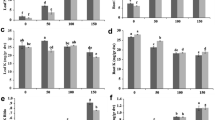Abstract
Key message
Depending on salt concentrations, different mechanisms are involved in the tolerance of pistachio and an acclimation to salinity conditions occurs in the leaves that develop in the presence of salt.
Abstract
Pistachio (Pistacia vera L.) is a salt tolerant species that is considered an alternative crop for cultivation in salinzied orchard soils. In this work, 12-week-old pistachio seedlings cultivated in soil under greenhouse conditions were treated with five levels of salinity including control (0.63 dSm−1), low (2 and 4 dSm−1) and high (8 and 10 dSm−1) salt concentrations for further 12 weeks. Plant growth parameters were not affected by mild salinity; a significant reduction was only observed from 8 dSm−1. Considerable differences were observed between the young and mature leaves regarding osmotic and ionic stress effects of salt. Main compatible solutes were proline in mature leaves, proline and soluble sugars in young leaves, and soluble sugars and amino acids, other than proline, in roots. Concentration and content of Na in the leaves were not significantly increased at low levels of salinity and the K:Na and Ca:Na ratio of leaves were affected only by higher salt concentrations. Using the sequential extraction procedure for cell wall isolation, we observed that both absolute and relative amounts of Na in the cell wall fraction increased under low salinity, while decreased under higher levels of salt supply. Stable water relations, photochemistry and CO2 assimilation rates particularly of young leaves, as well as ion homeostasis were mechanisms for maintenance of plants growth under mild salinity. Under severe saline conditions, the impaired ability of mature leaves for synthesis of assimilates, preferent allocation of carbohydrates to roots for maintenance of osmotic homeostasis and finally, reduction of protein synthesis caused growth inhibition in pistachio.


Similar content being viewed by others
References
Ashraf M, Harris PJC (2004) Potential biochemical indicators of salinity tolerance in plants. Plant Sci 166:3–16
Banakar MH, Ranjbar GH (2010) Evaluation of salt tolerance of pistachio cultivars at seedling stage. Am-Eurasian J Agric Environ Sci 9:115–120
Bastam N, Baninasab B, Ghobadi C (2013) Improving salt tolerance by exogenous application of salicylic acid in seedlings of pistachio. Plant Growth Regul 69:275–284
Bates LS, Waldren RP, Teare ID (1973) Rapid determination of free proline for water-stress studies. Plant Soil 39:205–207
Bose J, Shabala L, Pottosin I, Zeng F, Velarde-Buendia AM, Massart A, Poschenrieder C, Hariadi Y, Shabala S (2014) Kinetics of xylem loading, membrane potential maintenance, and sensitivity of K+-permeable channels to reactive oxygen species: physiological traits that differentiate salinity tolerance between pea and barley. Plant Cell Environ 37:589–600
Bradford MM (1976) A rapid and sensitive method for the quantitative titration of microgram quantities of protein utilizing the principle of protein-dye binding. Anal Biochem 72:248–254
Cabot C, Sibole JV, Barceló J, Poschenrieder C (2009) Sodium-calcium interactions with growth, water, and photosynthetic parameters in salt-stressed beans. J Plant Nutr Soil Sci 172:637–643
Chaves MM, Flexas J, Pinheiro C (2009) Photosynthesis under drought and salt stress: regulation mechanisms from whole plant to cell. Ann Bot 103:551–560
Chelli-Chaabouni A, Ben Mosbah A, Maalej M, Gargouri K, Gargouri-Bouzid R, Drira N (2010) In vitro salinity tolerance of two pistachio rootstocks: pistacia vera L. and P. atlantica Desf. Environ Exp Bot 69:302–312
Eimanifar A, Mohebbi F (2007) Urmia Lake (Northwest Iran): a brief review. Saline Syst 3:5. doi:10.1186/1746-1448-3-5
FAO (2012) http://faostat3.fao.org/faostat-gateway/go/to/download/Q/QC/E
FAO (2013) http://faostat3.fao.org/faostat-gateway/go/to/download/RL/*/E
FAO-Iran (2013) http://www.fao.org/countryprofiles/index/en/?iso3=IRN
Ferguson L, Poss JA, Grattan SR, Grieve CM, Wang D, Wilson C, Donovan TJ, Chao CT (2002) Pistachio rootstocks influence scion growth and ion relations under salinity and boron stress. J Am Soc Hortic Sci 127:194–199
Flowers TJ, Hajibagheri MA, Yeo AR (1991) Ion accumulation in the cell walls of rice plants growing under saline conditions: evidence for Oertli hypothesis. Plant Cell Environ 14:319–325
Hajiboland R, Bastani S (2012) Tolerance to water stress in boron-deficient tea (Camellia sinensis) plants. Folia Hort 24:41–51
Hasegawa PM (2013) Sodium (Na+) homeostasis and salt tolerance of plants. Environ Exp Bot 92:19–31
Hasegawa PM, Bressan RA, Zhu J-K, Bohnert HJ (2000) Plant cellular and molecular responses to high salinity. Annu Rev Plant Physiol Plant Mol Biol 51:463–499
Hoagland DR, Arnon DI (1950) The water culture method for growing plants without soil. Calif Agric Exp Stat Circular 347:25–32
Hwang M, Ederer GM (1975) Rapid hippurate hydrolysis method for presumptive identification of group B streptococci. J Clin Microbiol 1:114–115
Karimi HR, Ebadi A, Zamani Z, Fatahi R (2011) Effects of water salinity on growth indices and physiological parameters in some pistachio rootstocks. J Plant Nutr 34:935–944
Kronzucker HJ, Coskun D, Schulze LM, Wong JR, Britto DT (2013) Sodium as nutrient and toxicant. Plant Soil 369:1–23
Long SP, Humphries S, Falkowski PG (1994) Photoinhibition of photosynthesis in nature. Annu Rev Plant Physiol Plant Mol Biol 45:633–662
Longstreth DJ, Nobel PS (1979) Salinity effects on leaf anatomy consequences for photosynthesis. Plant Physiol 63:700–703
Magné C, Saladin G, Clément C (2006) Transient effect of the herbicide flazasulfuron on carbohydrate physiology in Vitis vinifera. Chemosphere 62:650–657
Mansour MMF (2000) Nitrogen containing compounds and adaptation of plants to salinity stress. Biol Plant 43:491–500
Maxwell K, Johnson GN (2000) Chlorophyll fluorescence-a practical guide. J Exp Bot 51:659–668
Müller P, Li X-P, Niyogi KK (2001) Non-photochemical quenching. A response to excess light energy. Plant Physiol 125:1558–1566
Munns R (1993) Physiological processes limiting plant growth in saline soils: some dogmas and hypotheses. Plant Cell Environ 16:15–24
Munns R (2002) Comparative physiology of salt and water stress. Plant Cell Environ 25:239–250
Munns R, Tester M (2008) Mechanisms of salinity tolerance. Annu Rev Plant Biol 59:651–681
Nooghi FH, Mozafari V (2012) Effects of calcium on eliminating the negative effects of salinity in pistachio (Pistacia vera L.) seedlings. Aust J Crop Sci 6(4):711–716
Parida AK, Das AB (2005) Salt tolerance and salinity effects on plants: a review. Ecotoxicol Environ Saf 60:324–349
Paul MJ, Foyer CH (2001) Sink regulation of photosynthesis. J Exp Bot 52:1383–1400
Pons TL, Jordi W, Kuiper D (2001) Acclimation of plants to light gradients in leaf canopies: evidence for a possible role for cytokinins transported in the transpiration stream. J Exp Bot 52:1563–1574
Rodrigues CRF, Silva EN, Ferreira-Silva SL, Voigt EL, Viégas RA, Silveira JAG (2013) High K+ supply avoids Na+ toxicity and improves photosynthesis by allowing favorable K+:Na+ ratios through the inhibition of Na+ uptake and transport to the shoots of Jatropha curcas plants. J Plant Nutr Soil Sci 176:157–164
Saqib M, Zörb C, Schubert S (2008) Silicon-mediated improvement in the salt resistance of wheat (Triticum aestivum) results from increased sodium exclusion and resistance to oxidative stress. Funct Plant Biol 35:633–639
Shannon MC, Grieve CM, Francois LE (1994) Whole-plant response to salinity. In: Wilkinson RE (ed) Plant-environment interactions. Marcel Dekker Inc, New York, pp 199–244
Sheibani A (1994) Pistachio production in Iran. Acta Hort 419:14–15
Shomer I, Novacky AJ, Pike SM, Yermiyahu U, Kinraide TM (2003) Electrical potentials of plant cell walls in response to the ionic environment. Plant Physiol 133:411–422
Sibole OV, Cabot C, Michalke W, Poschenrieder C, Barceló J (2005) Relationship between expression of the PM H+-ATPase, growth and ion partitioning in the leaves of salt-treated Medicago species. Planta 221:557–566
Szabados L, Savouré A (2010) Proline: a multifunctional amino acid L. Trends Plant Sci 15:89–97
Tattini M, Lombardini L, Gucci R (1997) The effect of NaCl stress and relief on gas exchange properties of two olive cultivars differing in tolerance to salinity. Plant Soil 197:87–93
Tester M, Davenport R (2003) Na+ tolerance and Na+ transport in higher plants. Ann Bot 91:503–527
Thiele A, Winter K, Krause HG (1997) Low inactivation of D1 protein of photosystem II in young canopy leaves of Anacardium excelsum under high-light stress. J Plant Physiol 151:286–292
Zhu J-K (2003) Regulation of ion homeostasis under salt stress. Curr Opin Plant Biol 6:441–445
Zohary D (1995) The genus Pistacia L. In: S. Padulosi, T. Caruso E. Barone (eds) Taxonomy, distribution, conservation and uses of Pistacia genetic resources. International Plant Genetic Resources Institute (IPGRI), Rome, p 145
Conflict of interest
The authors declare that they have no conflict of interest.
Author information
Authors and Affiliations
Corresponding author
Additional information
Communicated by U. Luettge.
Rights and permissions
About this article
Cite this article
Hajiboland, R., Norouzi, F. & Poschenrieder, C. Growth, physiological, biochemical and ionic responses of pistachio seedlings to mild and high salinity. Trees 28, 1065–1078 (2014). https://doi.org/10.1007/s00468-014-1018-x
Received:
Revised:
Accepted:
Published:
Issue Date:
DOI: https://doi.org/10.1007/s00468-014-1018-x




